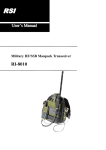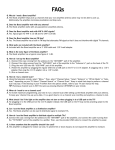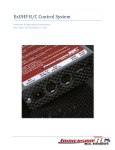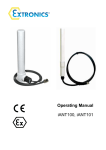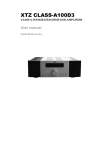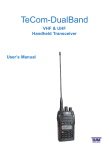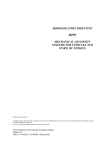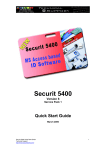Download RRSSSII
Transcript
RSI User’s Manual Military HF/VHF/UHF Vehicular Transceiver RI-8100 RI-8100 User’s Manual Contents 1. Installing and Preparing……………………………………………………………… 2 1) Accessories and Assembling …………………………………………………….… 2 2) DC Power Supplying …………………………………………………………….… 3 3) Connecting Antenna(AT-2.4) ………………………………………………….……3 4) Connecting Handset(HS-2) …………………………………………….…….…..… 3 2. Control Buttons and Sockets ………………………………………………….………3 1) Control Buttons of front panel ………………………………………………...…… 3 2) Information of Sockets …………………………………………………..….…….…5 3. Operation of Transceiver ………………………………………………….….…….…6 1) Power On/Off …………………………………………………………….….………6 2) Setting of Status Values …………………………………………………….……….6 4. Communication …………………………………………………………….………... 8 1) Public Voice Communication(Clear Mode) ……………………………….………. 8 2) Private Voice Communication(Encrypt Mode) …………………………….……….8 3) Send Messages ………………………………………………………….………….. 8 4) Frequency Hopping ……………………………………………………..………….. 9 5) Network Communication ………………………………………………..…………. 9 6) AutoScan Function……………………………………………………….………….10 7) AutoCall Function…………………………………………………………..……….10 8) ALE Call Function…………………………………………………………..……….10 9) Key Agreement …………………………………………………………………..….11 10) Data Communication ………………………………………………………………11 5. How to Use Editor Button ………………………………………………………..…..12 1) Edition of Alphabets and Characters ………………………………………………..12 2) Numbers Inputting ………………………………………………………………..…13 6. Specifications ………………………………………………………………………....14 -1- RI-8100 User’s Manual 1. Installing and Preparing 1) Accessories and Assembling a. Accessories - Handset(HS-2) - HF Automatic Antenna Tuner (AH-04) b. Options - Folded Dipole Antenna (AT-24.5) - VHF Antenna (AT-11) - RS-232C Cable(CA-2) - Morse Key(MK-02) - DC Power Supply(DPC-01) - Headset(HS-21) c. See Fig.1 for assembling of RI-8100. Handset(HS-2) Fig.1. Assembling of transceiver Headset(HS-21) RS-232C Cable(CA-2) HF Automatic Antenna Tuner (AH-04) Folded Dipole Antenna (AT-24.5) Morse Key(MK-02) VHF Antenna (AT-11) DC Power Supply(DPC-01) Fig. 2. Accessories and Options -2- RI-8100 User’s Manual 2) Power Supplying RI-8100 must be supplied by DC 9~12 voltage. - Connects to power plug, external power DC 12V. 3) Connecting Antenna (1) Connecting folded dipole antenna(AT-24.5) - Sets up AT-24.5 antenna for HF band. - Connects socket of AT-24.5 to ANT-HF socket on rear panel.(without AT-04) (2) Connecting VHF/UHF antenna(AT-11) - Sets up AT-11. - Connects AT-11 to ANT-VHF socket on rear panel. (3) Connecting other antenna - Sets up other antenna for HF band. - Sets up antenna tuner AT-04. - Connects AT-04 to ANT-HF socket on rear panel. - Connects other antenna with AT-04. 4) Connection of Handset - Insert the handset(HS-1) into handset socket. 2. Control Buttons and Sockets 1) Control Buttons of front panel - [CHANNEL/ESC ] Button -3- RI-8100 User’s Manual ㅇ Moves to channel mode in main mode(clear mode). ㅇ Moves to main mode in any mode. ㅇ If double clicks in message mode, moves to CHANNEL FREQ spread-receive mode. /\ ESC BS - [HOP/MAIN/<] Button (move left) ㅇ Moves to hopping mode in main mode. ㅇ Moves to main mode in hopping mode. HOP/MAIN TUNE MSG ㅇ Moves cursor to left in edit mode. < > - [TUNE/>] Button (move right) ㅇ Makes antenna to tune in selected frequency. ㅇ Moves cursor to right in edit mode. VOICE/DATA SET - [/\]([\/]) Button \/ MODE SEND ㅇ Increases(Decreases) value of selected item. - [FREQ/BS] Button ㅇ Moves to frequency mode in main mode. Fig.3. Control Buttons ㅇ Makes backspace in edit mode. - [MSG/ ] Button ㅇ Moves to message mode in main mode. ㅇ Moves cursor to next line in edit mode. ㅇ Saves value of frequency in frequency mode. - [SET/MODE] Button ㅇ Sets operating mode(LSB,USB,AM,CW). ㅇ Moves to set mode for power, hopping order, net number, local number and random number. - [VOICE/DATA/SEND] Button ㅇ Move to private mode. ㅇ Send message in edit mode. ㅇ If double click in message mode, send the edited messages by spread mode. - [VOICE/DATA/SEND] Button ㅇ Move to private mode. ㅇ Send message in edit mode. ㅇ If double click in message mode, send the edited messages by spread mode. -4- RI-8100 User’s Manual 2) Informations of Sockets in front and rear panels Display RS-232C Port Power Switch VHF Antenna Socket Ground Terminal Power Socket Handset Socket Tuner Socket Keyboard Morse Key Socket Fig.4. Front and Rear pannel HF Antenna Socket Table 1. Handset Connector Information. Connector PIN # NAME DESCRIPTION 1 GND Connects to ground. 2 Transmit While pushing [PTT], transmit voice. 3 Receive Receive voice. 4 - - 5 - - 6 PTT PTT sign 7 - - - Connector for RS-232C corresponding pins ① - ② ② - ③ ③ -5- - ⑤ : RI-8100 User’s Manual 3. Operation of Transceiver 1) Power on/off - Push and release [ON/OFF] button to turn on transceiver. ㅇ Then display memorized frequency, channel and operating mode to screen(Fig.5). ㅇ Character “Rx” appears in upper-right of screen. ㅇ Now transceiver is in clear mode as first status. - To turn off, Push and hold [ON/OFF] button while one second. Fig.5. Display 2) Setting of Various Values - Setting of channel Fig.6. Setting of channel This product have 100 channels. Channel setting is as follows: ㅇ Push [CHANNEL] button when clear mode. Then cursor blinks at position of channel number on screen(Fig.6). ㅇ Push [/\] button or [\/] button to up/down channel number. ㅇ Push [ESC] button to set channel. - frequency fine tuning and setting ㅇ frequency fine tuning · Push [FREQ] button in main mode. Then cursor blinks at position of 10Hz unit. · Push [/\] button or [\/] button to up/down frequency. · Push [ESC] button to return to main mode. ㅇ frequency setting · First push [FREQ] button twice in main mode.(Fig.7) · Use number keys to set frequency you want. (*) To set frequency of VHF/UHF band, press right arrow button [>]. Then frequency digits are shifted from “00.000.00” to “000.000.0”. Now you can use number keys to set frequency of VHF/UHF band(For example: 140MHz or 437MHz.) · Push [ ] button to keep the selected frequency. · Push [ESC] button to return to main mode. - Setting of operating mode ㅇ Push [SET/MODE] button in main mode. Then cursor blinks at position of operating mode. There are LSB,USB,AM,FM and CW modes. ㅇ Push [/\] button or [\/] button to select mode you want. ㅇ Push [ESC] button to return to main mode. -6- RI-8100 User’s Manual CH 01 Rx LSB 0 5,0 0 0. 0 0 FREQ CH01 Rx LSB 0 5,0 0 0. 0 0 CH 01 Rx LSB 0 4, 9 9 9. 9 0 “∨” -10Hz ” blink FREQ 0 6, 2 0 0. 0 0 SET 0 5,0 0 0. 0 0 0 5,0 0 0.1 0 0 0, 0 0 0. 0 0 +10Hz ...... ESC ESC CH01 Rx LSB 0 6, 2 0 0. 0 0 CH 01 Rx LSB 0 4,9 9 0.0 0 Fig.7. Setting of frequency - Volume control Push [/\] button or [\/] button to control volume of received signal. - Setting of communication mode (M-MODE) ㅇ In main mode, push [SET] button twice and push [<]([>]) button until “M-MODE” appears. Then power setting menu is displayed. ㅇ Push [/\] button or [\/] button to select “MANUAL” or “AUTO” mode. If “AUTO” mode is set, RI-8100’s transmitting channel can be changed between CH01~CH09 automatically. ㅇ Push [ESC] button to return to main mode. - Setting of power(POW) ㅇ In main mode, push [SET] button twice and push [<]([>]) button until “POWER” appears. Then power setting menu is displayed. ㅇ Push [/\] button or [\/] button to change power by step 1W. ㅇ Push [ESC] button to return to main mode. - Setting of hopping mode(HOP) ㅇ In main mode, push [SET] button twice and push [<]([>]) button until “HOP” appears. Then hopping setting menu is displayed. ㅇ Push [/\] button or [\/] button to select “RANDOM”, “ADAPTIVE” or “INTELLIG” mode. ㅇ Push [ESC] button to return to main mode. - Setting of network number(NET) ㅇ In main mode, push [SET] button twice and push [<]([>]) button until “NET” appears. -7- RI-8100 User’s Manual ㅇ Push [/\] button or [\/] button to select net number. ㅇ Push [ESC] button to return to main mode. - Setting of address(ADR) ㅇ In main mode, push [SET] button twice and push [<]([>]) button until “ADR” appears. ㅇ Push [/\] button or [\/] button to select address number. ㅇ Push [ESC] button to return to clear mode. - Setting of Random ㅇ In main mode, push [SET] button twice and push [<]([>]) button until “RANDOM” appears. ㅇ Push number button to select random number. If want to stop random number change, please push [ESC] button. Then original random number will be return. ㅇ After input random number, push [ ] button to keep the random number. ㅇ Push [ESC] button to return to clear mode. - Frequency tuning User can use frequency tuning function to maximize transmitting power. When you are in clear mode, Push [TUNE] button, then the transmitter is tuned automatically to the frequency. 4. Communication 1) Public Voice Communication(Clear Mode) When status setting is finished, you can make public voice communication. Push PTT button of Handset(HS-1) to transmit. Then “Tx” appears on screen. Release PTT button to return to receive. Then “Rx” appears on screen. If you want to change working frequency, use fine tune or frequency setting function to change it. 2) Private Voice Communication(Encrypt Mode) ㅇ Push button [VOICE/DATA] in clear mode to have private voice communication of 1200bps. ㅇ Double click button [VOICE/DATA] in clear mode to have private voice communication of 600bps. Then “Speech” is displayed on screen. You can take private voice communication. If you want to escape to clear mode, push [ESC] button once more. 3) Send Message User can take message sending in private mode. ㅇ Push [ ] button to edit messages. Then cursor appears on upper-left of screen. You can edit message using editor. ㅇ Editing finished, push [SEND] button to send message. -8- RI-8100 User’s Manual Then “IDnumber” and “Message Tx” appears on upper side of screen. number is current ID(1~8 or N). If no response from other side, “Resp no” appears on screen and transmitting and receiving repeat until there would be response. In receiving response, “Message Rx” appears on screen. If message receiving is ok, the message appears on screen of each other. To return to message receiving mode, push [ESC] button. To escape to clear mode in message receiving mode, push [ESC] button. ㅇ Editing finished, double-click [SEND] button to send message in spread spectrum mode. Then “Spread Tx” appears on upper side of screen. Note: For receiving of spread spectrum mode, User must push button [*] to display FUNC menu, and push button [8](PSK Rx) to enter to spread receiving mode. In receiving response, “Spread Rx” appears on screen. If message receiving is ok, the message appears on screen of each other. 4) Frequency Hopping ㅇ When you are in clear mode, push [HOP] button to move frequency hopping mode. Then “HopReady Tx” appears on screen. Send side and receive side repeat transmit and receive until synchronization is ok. Received, “HopReady Rx” appears on screen. ㅇ If synchronization between receive side and transmit side is ok, “HOP” appears upper of screen and move clear mode. ㅇ To make private voice communication or send message, repeat section 2) or 3). ㅇ Push [ESC] button to escape to clear mode in private voice communication. If you push [ESC] button in message edit mode, user will be in message receive mode. Then you can push [ESC] button to escape to clear mode. ㅇ In clear mode Push [HOP] button to stop hopping. 5) Network Communication Nestwork Communication is a way communicating between only members in a group. A group is a set of members who have same net number and same random number. User must know net number and random number of the group to become a member of the group. Saying, Network Communication(Group Communication) is a mode communicating between members who has the same NET and the same ADR each other. To process net communication: ㅇ Sets random number(RANDOM). Refer to 3.2) Setting of Various Values. ㅇ Sets net number(NET). ㅇ Sets current ID to “N”. ㅇ Process a communication. (*) Network communication is possible in only Private Voice mode. -9- RI-8100 User’s Manual 6) AutoScan Function In AutoScan Mode the transceiver scans automatically from Channel 00 to Channel 99. This means that when the caller and the called differ in Channel, the called side’s Channel will be set to the caller side’s one automatically. AutoScan Function requires that the caller and the called should be the same frequency and mode from Channel 00 to 99. To process AutoScan mode: ㅇ In Clear mode Push button [*] to enter Function Setting mode. ㅇ Push button [4]. Then “AutoScan” will be appeared in display. When signal received, the transceiver will stop scanning and response to the calling. The mode will be set automatically to the calling mode(message or voice). ㅇ Push button [ESC] to escape. 7) AutoCall Function In AutoCall Mode the transceiver transmits automatically from Channel 00 to Channel 99. This means that when the caller and the called differ in Channel, the caller side’s Channel will be set to the called side’s one automatically. AutoCall Function requires that the caller and the called should be the same frequency and mode from Channel 00 to 99. To process AutoCall mode: ㅇ In Clear mode Push button [*] to enter Function Setting mode. ㅇ Push button [5]. Then “AutoCall” will be appeared in display. When response signal received, the transceiver will stop transmitting and move to Clear mode. Then “Ok” will be appeared in display. 8) ALE Call Function In ALE Call mode the transceiver selects automatically frequency in ALE List and transmits. ALE Call Function requires that the caller and the called maybe not the same frequency and mode from Channel 00 to 99. To process ALE Call mode: ㅇ In Clear mode Push button [*] to enter Function Setting mode. ㅇ Push button [6]. Then “ALE Call” will be appeared in display. When response signal received, the transceiver will stop transmitting and move to Clear mode. Then “Ok” will be appeared in display. - 10 - RI-8100 User’s Manual 9) Key Agreement Transmission Encryption Key(TEK) can be agreed any time and the key is stored with current ID. a) How to exchange TEK - First, A requires B to waiting for his call. - B push button [1] and waits for A’s call. - A starts key agreement by pressing button [2]. - OK is appeared on the display of B and also A. Then the key agreement is finished successfully. - The new TEK is stored with current ID. User may see what current ID is. b) How to set current ID Transmission Encryption Keys of 8 can be stored with IDs of 8. In clear mode after pressing button [*], to press button [3] will be show current ID to you. To change current ID, press button [/\] or [\/] till ID that you want is seen. c) Buttons for Key Management Button [*] - displays FUNC menu to operate Key Management. Button [1] - waits for call for key agreement. Button [2] - starts key agreement. Button [3] - views or set current ID. d) Note * During key exchanging, you must not touch any key. If Key Agreement is not finished successfully, you must re-take the procedure. * ID 8 is for network communication. 10) Data Communication by Computer It follows to communicate data by computer: ㅇ Connects between the device and RS-232C port of computer by the provided RS-232C cable(CA-2). ㅇ Powers on the device. ㅇ Push button [*] to display FUNC menu. ㅇ Push button [\/] to select data communication mode. ㅇ Push button [9]. Then “PC comm” appears in display. ㅇ Starts up program SHIELD installed in computer and makes communication you want by the program.(Refer to SHIELD User ‘s Manual.) While data communicating, “Rx” appears in display during receiving and “Tx” appears during transmitting. If no response, “Resp No” appears. - 11 - RI-8100 User’s Manual 5. How to Use Editor Button In the state of message edit, user can edit with English/Symbols and Number. 1) English and Symbol entry mode - Push [BS] button to switch to the English/Symbol entry mode from clear mode. Then dot appears at the right bottom in the display. Fig.8 Entry Mode switch - Push corresponding button continuously until the letter you wanted appears. To entry the letters in the same button, wait 0.5 sec until cursor moves the next position after the first letter appears and repeat previous operation for second, third, fourth letters. For example, to entry “AB”, wait 0.5 sec after “A” appears with pushing “ ABC” button and cursor moves next position, then push [ABC] button to entry “ B”. (*) All English letters are fixed within 0.5 sec after appeared or with pushing other buttons before less than 0.5 sec. - Push [ * ] button to switch between large letter and small one. - Push [ # ] button to make the space. - 15 symbols are arranged in the [1] button, push continuously this until appears the symbol you wanted. Symbol is fixed within 0.5 sec. Symbols arranged in “1” button are shown below. ! " # $ % & ' ( ) * + , -. / - Symbols are also arranged in the English letter button with English letters. - 12 - RI-8100 User’s Manual When edit symbols, push corresponding button continuously until symbol you wanted appears. Selected symbol is fixed within 0.5sec. 2) Number entry mode - Push [MODE] button momentarily to switch to the number entry mode from English/Symbols mode. Then dot appears at the right center in the display. - Push corresponding number button to entry the number you wanted. - To process the space function, push [#] button . - 13 - RI-8100 User’s Manual 6. Specifications General Receiver Frequency range 1.6~200MHz, 430~450MHz Preset channel numbers Operating modes Sensitivity 100 SSB and data 0.16 uV (at 10dB S/N) USB, LSB, CW, AM, FM AM 2 uV (10dB S/N) Simplex/Half-duplex FM 0.25 uV (12dB SINAD) Frequency Hopping(ECCM) Selectivity more than 2.1KHz/-6dB ALE, Encrypted voice More than 4.5KHz/-60dB Channel scanning Image rejection more than 70dB Data/Message Phone 600 Ω(1000Hz) Frequency stability ±0.5ppm Channel spacing 100Hz Antenna tuning automatic(external) Silent tuning 45 Real-time encryption Tuning time 1~2.5s Key length 128/192/256 bit Supply voltage DC 9~14V Key agreement Elliptic Curve 160/320 bit TEK storage 8 Voice bit rate 2400/1200/600 bps Modem Coded PSK (serial tone), Data and Digital Voice Encryption Supply current Receive standyby 1.3A(at 13.8V) max.audio 2.0A(at 13.8V) Transmit max 20A(at 13.8V) Antenna connector 50 Ω Handset connector FQ14-7Z Size and weight AES (OFB) MSK Data mode simplex: FEC2, Half-duplex: FEC2-ARQ 332 x 317 x 160mm, 8.2Kg Data rate 75 ~ 2400bps Transmitter Frequency Hopping Power out Hop rate 10 hop/s SSB, CW, FM 2 ~ 125W Hop range 0.3~3MHz AM 2 ~ 50W Sync. Time Max. 15s Sync channels 8 Modulation SSB balanced AM low level FM variable reactance Environmental Carrier suppression more than 40 dB Operating temperature -40oC ~ +60oC Unwanted sideband more than 50 dB Storage temperature -40oC ~ +80oC Audio response 200 ~4000Hz Environmental rating immersion, shock, Specifications are subject to change without prior notice - 14 -















